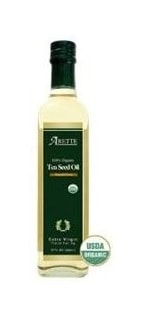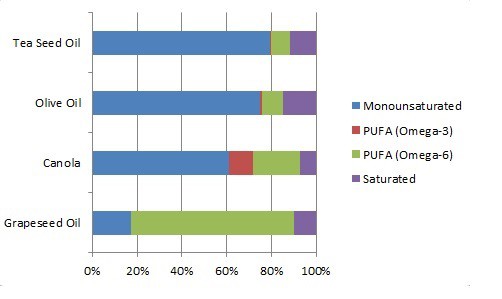 Not to be confused with tea tree oil, tea seed oil is an edible oil pressed from the seeds of Camellia oleifera, a small shrub related to Camellia sinensis, or tea plant. I recently received some samples from Arette, a company that distributes organic tea seed oil. As this product may be unfamiliar to many of you, I thought I’d post a quick review/introduction.
Not to be confused with tea tree oil, tea seed oil is an edible oil pressed from the seeds of Camellia oleifera, a small shrub related to Camellia sinensis, or tea plant. I recently received some samples from Arette, a company that distributes organic tea seed oil. As this product may be unfamiliar to many of you, I thought I’d post a quick review/introduction.
Culinary Features
Tea seed oil has a thin, light texture, similar to almond or grapeseed oil–much less viscous and “oily” than, say, olive oil. The flavor is also very light and clean. There are times, of course, when you’d want a more robust oil–but for times when you’re looking for a light touch, tea seed oil fits the bill.
Tea seed oil makes a light, delicate vinaigrette, perfect for delicate greens that might be weighed down or overwhelmed by the flavor of a heavier or heartier oil. Vegetables sauteed in tea seed oil remain almost dry to the touch, without the oily sheen you’d get from a heavier oil.
Nutritional Properties
Tea seed oil also has some unique nutritional properties. Although the texture reminds me of grapeseed oil, tea seed oil has a very different fatty acid profile.
While grapeseed oil is very high in polyunsaturated fats (primarily omega-6), tea seed is predominantly monounsaturated which, in my mind, offers two unique advantages.
Tea seed oil is excellent for high heat cooking. As I explained in a recent podcast, polyunsaturated oils form harmful compounds when heated–even when they have a very high smoke point. For that reason, I suggest cooking with oils that are low in PUFAs.
Tea seed oil is low in omega-6. I also suggest limiting your use of vegetable, nut, and seed oils because they tend to be high in omega-6 fats. Although omega-6 fats are not inherently bad for you, research suggests that an imbalance of omega-6 and omega-3 fatty acids can be a risk factor for many diseases. (More about that here.)
Because it is high in monounsaturated fat and low in omega-6, olive oil has long been my primary culinary oil–and there’s still a place in my kitchen for its distinct flavor and texture. Tea seed oil, on the other hand, is even lower in PUFAS (and omega-6), and offers a lighter flavor and texture, making it a welcome addition to my line-up!
See also: Is there an optimal ratio of MUFAs, PUFAs, and Saturated Fats?
Look for tea seed oil in gourmet shops or online. A half-liter bottle costs about $15, comparable to a high-end olive or nut oil. Frankly, that’s a bit too pricey to be my all-purpose, go-to bottle but worth keeping on hand for those times when you need a light, neutral oil–especially for high heat cooking.


Interesting. Do you know if any traditional cultures use this oil?
It looks like it’s more common in Asia, which is where the plants traditionally grow.
It looks like a refined oil. Do you know the smoke and flash points?
The Arette product I sampled is cold-filtered and extra virgin as well as organic. It may be filtered, however. The smoke point is 485F.
Thank you!
Amazing! Its truly remarkable article, I have got much clear idea regarding from this paragraph.
IT COMES FROM CHINA. HOW DO YOU KNOW IF YOU’RE RECEIVING A PURE, SAFE AUTHENTIC PRODUCT? REMEMBERING THE OLIVE OIL FIASCO…